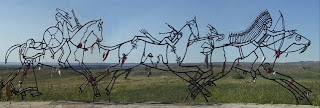It is a beautiful summer morning and I just came from a visit to the Depot Center Museum in Livingston. Even though it is in my hometown, I don't visit often enough. While I was making my way through the the exhibits, I came across a telegraphy key where patrons could try tapping out a message. I learned Morris code as a kid, but it had been a long time since I had attempted to use it. I couldn't resist giving it a try and my efforts made me realize the skill it took for telegraphers to send messages.
Thinking about how difficult it would have been to master this skill reminded me of something I had read about the events following the Battle of the Little Bighorn, in the National Park Service Handbook online. http://www.cr.nps.gov/history/online_books/hh/1a/hh1j.htm
According to the National Park Service Handbook:
"To send out news of the battle, J. M. Carnahan, the telegraph operator at Bismarck, took his seat at the telegraph key and for 22 hours he hardly moved from his chair. Upon completion of this message, he remained another 60-odd hours at the key without rest or sleep sending newspaper dispatches throughout the country."
I cannot imagine what that would have been like. It is hard enough to sit at a computer for more than a few hours, but to have to spell out each word with a series of long and short taps, it was an amazing feat. At the time the telegraph was invented it was considered to be such an advance in communication. Can you imagine what those early telegraph operators would have thought about the internet?




